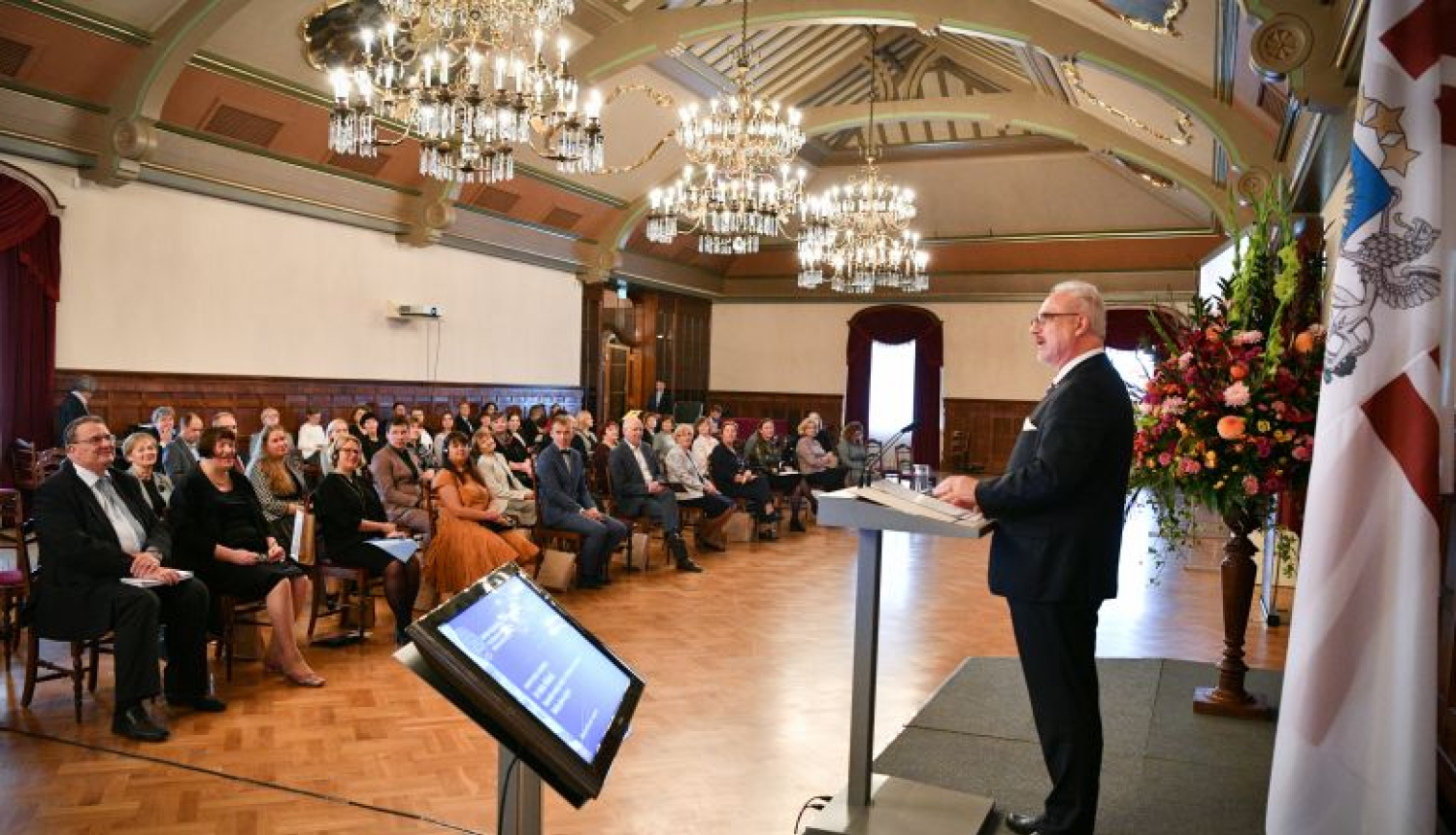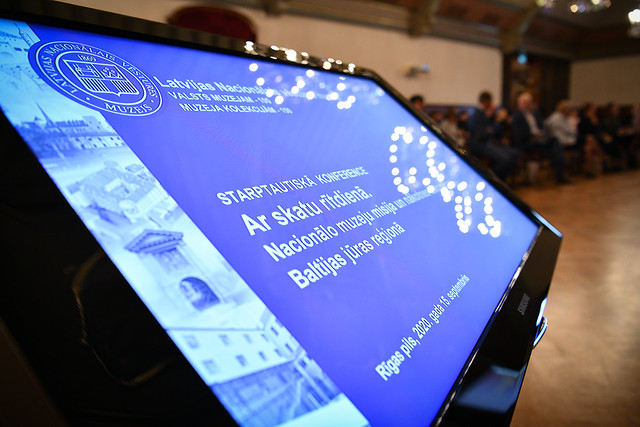Good morning, dear ladies and gentlemen,
Participants,
Honourable Mister Radiņš,
Staff of the National History Museum,
Guests, Mister Minister, members of the Saeima,
Congratulations everyone on another important milestone for Latvian historians as today marks hundred years of the National History Museum of Latvia. I would like to share with you some of my own ideas as to what these 100 years of museum mean to us today.
By the way, I do hope that our dear good neighbour, National History Museum of Latvia, will soon return to Riga Castle where President of Latvia resides.
It is remarkable that the museum and the president live under the same roof. Museum is the embodiment of people’s and later on nation’s self-identification, self-awareness and self-reflection, whereas the state of Latvia, with president at its helm, emerged as a result and fulfilment of nation’s desire for self-determination. Without it, our state would not have its history.
By the way, there is quite an interesting story of how we became neighbours. Back then, in 1920, when the museum was looking for home, somebody suggested that Riga Castle has plenty of space to offer. And living under the same roof also has symbolic meaning.
Nation as a political community thrives on several elements: its own language, culture, traditions, shared beliefs rooted in geographic affiliation and, most importantly, collective memory, which every nation has. Memories of shared past contribute to sense of unity between people, or what we also know as common destiny.
No country can go on without deeper understanding of its history. Historical events, their interpretation, are part of national identity, and I as a lawyer believe that they are also part of constitutional identity defined by Satversme. Therefore, understanding of history, ideas about past, our shared past, also give us the right to claim that this is our country, we need it, we live here, and this is the kind of future we are building.
Ladies and gentlemen,
History is never done or finished. Dear historians, that means you will always have plenty to do.
History is a work in progress. Not only because new time layers, which need to be studied, are constantly added. It keeps evolving because new facts about long-gone events, new artefacts and new historical evidence is discovered all the time. It also keeps evolving because every time we or rather you, dear historians, touch it, new meaning is added to our knowledge about history.
Each new generation comes with its own experience. Its understanding of past and historic events leaves a trail in our perception of history. We can even draw parallels with physics. Nuclear physics is basically about scientists trying to show how, for example, certain particles behave. By trying to take measurements as evidence of certain patterns they actually alter these particles. We cannot detect anything without touching it. History is similar in this sense. Historians try to touch history. They leave finger marks or their own take on historic events. Their explanations, or touch, forms a rational historic understanding of series of isolated and seemingly unrelated events of the past.
Moreover, the same historic fact can be interpreted differently. If such interpretation is based on verified methodology (this is where the question about the impartiality of historic accounts comes in, and we should make it as impartial as possible), it will always fall within the ‘range of believable’. And this range of believable forms our today's understanding of history, it contributes to pluralistic view of history intrinsic to a democratic society. We have several historians who interpret the same facts differently. But let me reiterate, their interpretations still fall within the range of believable. There is a clear line between what is within the range of believable and what falls beyond it. Everything that goes beyond it is considered a falsification. And there, of course, are falsifications, but the line between real, accepted history, which strives for evidence-based interpretations, and falsifications is also quite clear. By the way, probably falsified history that we learned during the Soviet occupation has already become a part of our history, and it would probably be worthwhile researching how much of it is fake.
That is why I cannot emphasize enough how important it is for historians to devote their intellectual power to explain, interpret and try to understand history as much as discovering new historic facts.
Ladies and gentlemen,
National History Museum of Latvia holds one of the most diverse collections of historical objects that represent the history of Latvian nation and the state, including archaeological, ethnographic, numismatic items from middle ages to modern times and most recent history. There is also the term ‘recent’ or contemporary history, which, of course, overlaps with political science. However, I am convinced that time period one generation back is already a history that needs to be studied. Political scientists, of course, should also study this period, and vice a versa, historians should also be concerned with current events.
National History Museum, like other national museums, archives and National Library, is not only managing its collections and studying historic facts. It is also one of the most important memory institutions.
Let me stress, memory policy is a legitimate and integral part of political constellation of a democratic country, and National History Museum is one of the bodies responsible for implementation of this policy.
The mirror held up by the museum to show each next generation our nation’s and state’s history, and its course, plays an immense role. Like human memory that tends to filter past through today's perspective, History Museum as memory institution does a very important work. It picks certain facts out of all the range of historic facts, illuminates them and plants them into today's understanding and awareness of people, which determines our behaviour on the individual and collective level.
One of the most vivid examples of what Museum of History does in terms of promoting the historic memory of the Latvian nation is the exhibition 100 years of Latvia put together in collaboration with other Latvian museums.
This exhibition accentuated and strengthened the notion of Latvia, encouraged to think about how the idea and the meaning of Latvia evolved through different generations and periods of history, while its core concept remained the same throughout the times, surviving various political systems and historic eras. New generation historians interpreted authoritarian and occupation regimes from today's democratic perspective, thus contributing to further research of Latvian history and development of collective memory. This exhibition enhanced our understanding of our own history and enriched our worldviews. But even more so, our national identity.
Looking from the perspective of major tragic turning points in the 20th century history of Latvia, this memory policy area deserves to be developed further. I believe, looking at the 20th century, that our memory policy should be much more nuanced, stronger, clearer and ambitious. That, of course, is not only the responsibility of the History Museum but also the duty of the community of historians.
Let me also raise another issue. Since we are a part of the European history since ancient times, throughout medieval times up to modern history and recent times, we must also be more active in contributing to the shared understanding of Europe’s history.
That primarily means that we have to fill the gaps in our national history first. Take any period of history - Livonian times, Duchy of Kurzeme–Zemgale, Renaissance or Romanticism, up to Young Latvians, World War I, Soviet occupation, including resistance movement that emerged after World War II. And I could still go on. There are numerous unexplored, unstudied periods of Latvian history that we constantly stumble upon. Even when it comes to periods of history that have been studied more thoroughly, we know more about politics an economy of the time, but we know very little or nothing at all about social and cultural processes of those periods because they have been either not studied at all or studied only partly.
That is why I'm extremely grateful to all the historians who despite the lack of public funding and meaningful historic policy have tirelessly worked to achieve high professional standards. But there is a lot to be researched still.
Secondly, we will have to ground our history in the overall historic framework of Europe. In other words, research on historic events that took place in Latvia will have to be tied to broader historical context of Europe. We will also have to enhance our cooperation with leading historians in Europe.
Historic studies of most Western European countries like France, Belgium or England still offer a rather fragmented and incomplete account of historic events that took place in Eastern Europe. We need to be proactive and persistent. We must contribute to a better understanding of the shared history of Europe in Western part of it. Common history of Europe, not just its Eastern part. For many Western Europeans its history is narrowed down to history of Central and Western Europe, while Eastern European experience is largely missing from the overall picture. And such an understanding of shared European history is slightly skewed, and we need to correct it. Many current political, social and cultural processes taking place at the European level are a perfect example of this rather one-sided, incomplete understanding of the shared history of Europe.
In order to let Latvian historians reach their research targets, Latvia needs history and memory policy that matches the 21st century needs. Public funding must also be appropriate. Our history was twisted for 50 years while we were occupied, and then it was underfunded for 30 years. We have access to studies on better researched periods of history. However, as a modern and mature country, Latvia needs the big picture. This, and other governments that will follow, need to be aware of that. As I already mentioned in the beginning, history is a work in progress and is never finished. Its wheels keep turning.
Dear historians, ladies and gentlemen,
The father back our collective memory stretches, the better will we be able to see our more distant future. By enhancing our knowledge of the past, you are shaping also our future.
In conclusion, let me underline that I am very much looking forward to return of the National History Museum to the Riga Castle. We really miss our dear good neighbour.
Thank you for what you are doing. Congratulations on your professional milestone once again!





